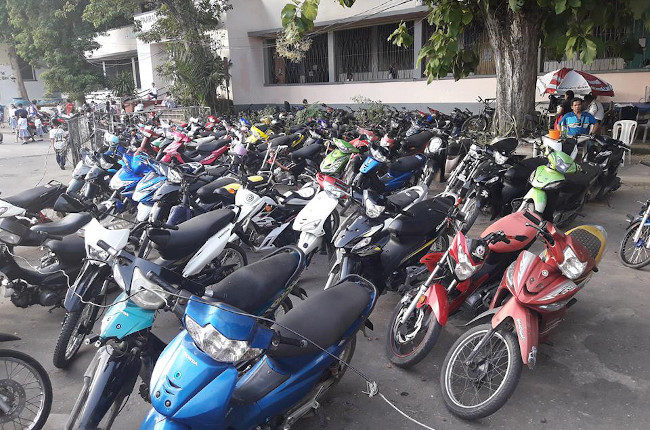What to do if your motorcycle gets impounded
Staying organized is the best way out of this sticky situation.

Few things are as big of a hassle as having your motorcycle towed and impounded following a traffic violation. Not only is it a waste of time, as this can end up having you spend more than a whole day just sorting things out, it’s also a waste of money, as certain violations come with a hefty penalty in order to set right. Getting your bike impounded is certainly a disaster in and of itself, however, there are several things you can do to make things more manageable, should you ever find yourself in this sticky situation.
Reasons your bike can get impounded

More often than not, your motorcycle can get towed and delivered to an impound lot because of inconsistencies in registration, your license, or if it has been suspected to be a stolen vehicle. Other than that, authorities in certain locales can also tow your motorcycle if it’s illegally parked, or if you figured in an accident. Diving into a little more detail, one of the biggest reasons a bike would get impounded would be due to documentation issues. If you as the rider don’t have a driver’s license, or if your motorcycle doesn’t have any registration documents, that’s almost a guaranteed ticket to the nearest impound lot.
Additionally, parking your motorbike in an unauthorized area, such as the sidewalk, pedestrian crossings, or PWD ramps can also be an easy way for you to get your bike towed. This is especially true in cities like Manila, Makati, and Quezon City, which enforce strict anti-obstruction ordinances in certain areas. Lastly, if you figure in an accident, chances are the authorities will tow your motorcycle and deposit it in the nearest impound lot while you work on procuring the resources to have the bike transported to your repair shop of choice, or have your insurance adjuster inspect the damage.
How to claim an impounded motorcycle

Once your motorcycle gets impounded, be sure to keep calm and have an organized mindset. The first thing to do would be to take several photos of the incident, such as the license plate of the tow truck, as well as the exact location of the incident. On top of that, make sure to ask the traffic enforcers about the exact details of the impound lot or police station they’ll be taking your bike to. It also helps to remain calm and respectful when talking to the officers, as they’re just doing their jobs. Ask them about the procedure in claiming the impounded vehicle, as well as where to settle the fines for the violation.
Chances are you’ll be issued an OVR, or Ordinance Violation Report. This comes with a corresponding fine, as well as the details on which the fines can be settled. Make sure to pay these fines as soon as possible. Once settled, bring the official receipt and any other documentation that certifies you’ve paid for the violation, to the impound lot or police station wherein your motorcycle is being held. Once approved, you may need to pay an additional impound fee, depending on the rules and regulations of the local government unit.
Avoid situation

As you can probably tell by now, getting your motorcycle impounded is very, very costly—not just financially, but also in terms of time. Of course, it’s always best to avoid the situation by following traffic rules and regulations at all times. For starters, always make sure to carry all pertinent documentation with you at all times. This means your driver’s license, your bike’s updated registration documents, as well as all other accompanying certifications that grant you authority to use the motorcycle.
Apart from that, always make sure to park your vehicle in designated parking spaces. Never leave your motorcycle parked on the sidewalk, shoulder, or curb, as this is almost a guaranteed trip to the impound lot. It’ll surely be worth the added walking distance to park in a designated parking area, instead of losing a couple of days just sorting out your violation and claiming your motorcycle from the impound lot.
Related Articles
-
Last-minute Christmas gift ideas for your rider friends and family / Featured Article
Struggling to think of gift ideas for your motorcyclist friends and family? Read on to get some inspiration this gift-giving season.
-
Motorcycle 101: The inner workings of a slipper clutch / Featured Article
Slipper clutches are awesome as they make for more forgiving downshifts and a lighter clutch lever. Let’s take a closer look at them and see how they work.
-
5 things to remember when shopping for new motorcycle tires / Featured Article
Here are 5 things to consider when time comes for you to replace the tires on your motorcycle.
-
4 bike-packing hacks for long adventures / Featured Article
Here are a few tips and tricks when it comes to packing for multi-day trips on your motorcycle
-
Tips and tricks for long-distance riders / Featured Article
Follow these tips and tricks when getting ready for a long-distance ride on your motorcycle.
Latest Features
-
Last-minute Christmas gift ideas for your rider friends and family / Featured Article
Struggling to think of gift ideas for your motorcyclist friends and family? Read on to get some inspiration this gift-giving season.
-
Ride a naked sportbike? Get these 5 upgrades first / Featured Article
Here’s a quick list of 5 upgrades to your naked sportbike to enhance your riding experience.
-
Motorcycle 101: The inner workings of a slipper clutch / Featured Article
Slipper clutches are awesome as they make for more forgiving downshifts and a lighter clutch lever. Let’s take a closer look at them and see how they work.






